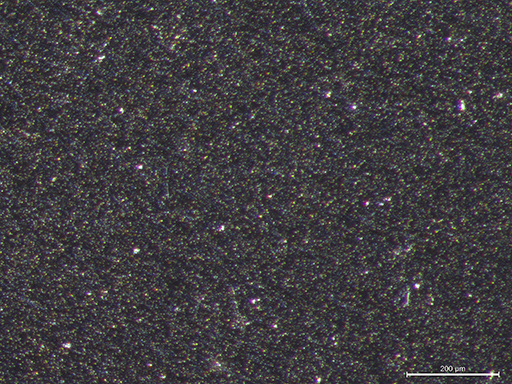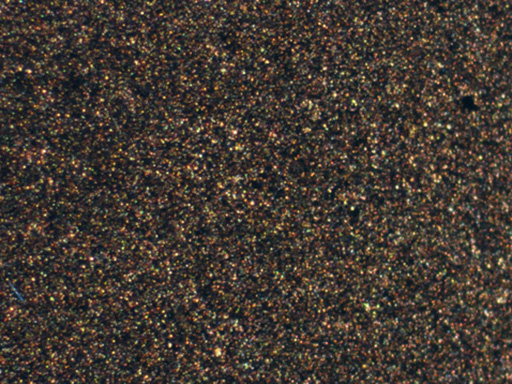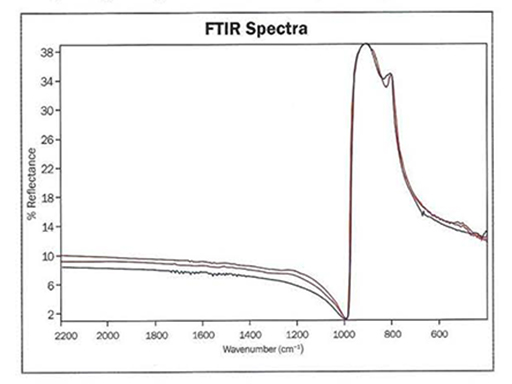
Large Black Sintered Moissanite as a Black Diamond Imitation
Two black, opaque, flat round gems were received at GGTL Laboratories Switzerland in October 2014 for certification as black diamonds. The samples weighed approximately 29 and 34 ct and measured 28.0-28.3 x 3.7 mm and 29.2-29.5 x 4.0 mm, respectively.
Microscopic observation piqued our attention because the gems did not show features consistent with a natural black diamond (i.e. an irregular distribution of brown-to-black inclusions of various shapes, dense clouds, etc.), heat-treated black diamond (minute graphite inclusions), or "classic" black synthetic moissanite (very dark green-to-blue or brown body colour, etc.). Strong fibre-optic illumination revealed a dark grey body colour with an olive tinge (Figure 1) and reflected light showed a very fine-grained homogeneous texture (Figure 2-top).

Figure 1: Viewed with the microscope and 250 W fibre-optic illumination, the synthetic moissanite samples showed a dark grey body colour with an olive tinge. Photomicrograph by F. Notari.
The microtexture was very similar to that of black ceramic material (boron carbide) imitating black diamond that was described by Choudhary (2013; see Figure 2-below) but was different from the mosaic pattern in black synthetic moissanite described by Moe et al. (2013). Minute interstitial spaces in our samples measured 5-150 μm (mostly ~50 pm).


Figure 2: On the top, the 34 ct synthetic moissanite shows a very fine-grained homogeneous texture with minute reflecting particles. A similar texture is shown in the image below of a boron carbide black diamond imitation. Top: Photomicrograph by F. Notari ; Below: Photomicrograph by Gagan Choudhary (magnified 48x; reprinted with permission from Choudhary, 2013).
The two gems were inert to long- and shortwave UV radiation but showed faint orange fluorescence when exposed to the intense 300- 410 nm excitation of the GGTL DFI luminescence microscopy system. Their RI was over the limit of our refractometer (> 1.81), and they tested positive for diamond with a thermal conductivity tester. The hydrostatic SG of the two samples was 3.16, and a hardness test showed >9 on the Mohs scale. (Hardness was tested with the client's permission on the girdle at 160x magnification.)
Specular reflectance FTIR spectra were recorded for both gems using a Thermo Nicolet Nexus spectrometer with a DTGS (deuterated triglycine sulphate) detector, by accumulating 20 scans at room temperature at a resolution of 4 cm-1 . The spectra showed features corresponding to a reference sample of green synthetic moissanite (Figure 3).

Figure 3: The specular reflectance FTIR spectra of the two gems (red lines) provide a close match to the reference sample of green synthetic moissanite (blue line).
EDXRF chemical analysis was also performed on both gems, using a Thermo Noran QuanX-EC instrument with all available filters (count time of 300 s and a beam diameter of 3.5 mm). The analyses showed major amounts of Si and traces of Fe, Cr and Ti. This is consistent with synthetic moissanite, which has a chemical formula of SiC (carbon cannot be detected by this instrument). The Fe, Cr and Ti are likely contained in the impurities that give the black appearance to this material.
Our analyses indicate that these two gems are opaque black synthetic moissanite with a very fine-grained structure. The SG of 3.16 is helpful for its identification (compared to diamond's 3.54 and boron carbide's 2.40). Monocrystalline synthetic moissanite has a typical SG of 3.22, and the lower value obtained for these samples is probably due to their being some type of sintered product rather than a monocrystalline material. Such sintered dark grey synthetic moissanite is available for industrial applications (e.g. Saddow and Agarwal, 2004). Conclusive identification of this material as synthetic moissanite was shown by specular reflectance FTIR spectroscopy and EDXRF analysis.
This type of black synthetic moissanite is now clearly available in the market as large cut gems. In October 2014 we bought a sample weighing 210.65 ct (diameter ~41 mm) for comparison, and our observations and analyses of this gem were consistent with those described here.
References
- Choudhary G., 2013. Gem News International: Boron carbide: A new imitation of black diamond. Gems & Gemology, 49(3), 180-181.
- Moe K.S., Johnson P. and Lu R., 2013. Lab Notes: Large synthetic moissanite with silicon carbide polytypes. Gems & Gemology, 49(4), 255-256.
- Saddow S.E. and Agarwal A., Eds., 2004. Advances in Silicon Carbide Processing and Applications. Artech House, Norwood, Massachusetts, USA, 228 pages.
Authors
- Candice Caplan, GGTL Laboratories Switzerland. ResearchGate, LinkedIn.
- Dr. Thomas Hainschwang, GGTL Laboratories Liechtenstein. ResearchGate, Linkedin.
- Franck Notari, GGTL Laboratories Switzerland. ResearchGate, LinkedIn.
© The Gemmological Association of Great Britain. This article was published in "The Journal of Gemmology". (2015), Volume 34, Issue 5, pp 399-401.
